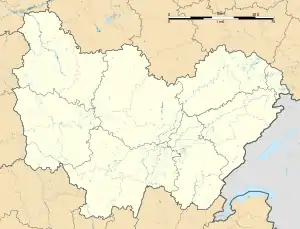Veilly
Veilly is a commune in the Côte-d'Or department in eastern France.
Veilly | |
|---|---|
 The church in Veilly | |
.svg.png.webp) Coat of arms | |
Location of Veilly 
| |
 Veilly  Veilly | |
| Coordinates: 47°07′40″N 4°35′59″E | |
| Country | France |
| Region | Bourgogne-Franche-Comté |
| Department | Côte-d'Or |
| Arrondissement | Beaune |
| Canton | Arnay-le-Duc |
| Government | |
| • Mayor (2008–2014) | Daniel Barbier |
| Area 1 | 5.39 km2 (2.08 sq mi) |
| Population (2017-01-01)[1] | 41 |
| • Density | 7.6/km2 (20/sq mi) |
| Time zone | UTC+01:00 (CET) |
| • Summer (DST) | UTC+02:00 (CEST) |
| INSEE/Postal code | 21660 /21360 |
| Elevation | 384–452 m (1,260–1,483 ft) (avg. 398 m or 1,306 ft) |
| 1 French Land Register data, which excludes lakes, ponds, glaciers > 1 km2 (0.386 sq mi or 247 acres) and river estuaries. | |
Veilly is a remote farming village in Bourgogne-Franche-Comté with Celtic-Gaulish origins (named "vidu" in Gaulish meaning the forest).
Veilly was part of the Duchy of Burgundy and enjoyed the status of "passive witness" of the Duchy's rich history.
Then, since Burgundy was integrated in the Kingdom of France, Veilly started to play with its real strengths: (i) eating, (ii) drinking (iii) and growing a little red in the face. In this respect, its location is ideal: next to the wine-producing area (Hautes Côtes de Beaune), to the vast and deep forest of Le Morvan, and to rich farming and growing areas (L'Auxois).
Veilly once loomed big in matters of Catholic faith as it had its own Saint, Cassian of Autun, and its own miracle, the mysterious erection of the statute of Notre Dame de Consolation which was found under the ground. These traditions remain strong in the village: a pilgrimage is organised every year on the 15th of August, and St Cassien has remained the patron of the Village (you may see statutes of him in various places of the village).
No aristocrats lived in Veilly for the last 1000 years which has preserved a peaceful social climate in the village (beside one or two agents of the Lords of the Manor). In this respect, the Manor House was located in the neighbouring medieval castle of Antigny-le-Chateau (château de Foissy). More historical research needs to be done in order to ascertain whether the different lords misbehaved or not. The facts are, however, blatant: in the surrounding villages, the peasants of Veilly were probably the last to be freed from serfdom at the eve of the French revolution.
Population
| Year | Pop. | ±% |
|---|---|---|
| 1962 | 52 | — |
| 1968 | 66 | +26.9% |
| 1975 | 61 | −7.6% |
| 1982 | 60 | −1.6% |
| 1990 | 59 | −1.7% |
| 1999 | 64 | +8.5% |
| 2008 | 54 | −15.6% |
See also
References
- "Populations légales 2017". INSEE. Retrieved 6 January 2020.
| Wikimedia Commons has media related to Veilly. |
